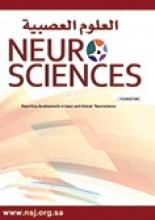Abstract
We describe a patient who presented with a pure topographical disorientation after a stroke involving the right mesial occipito-temporal cortex. He could not point to external unseen landmarks or draw a map of his city, while he could recognize landmarks, and judge the distance, and describe the route between pairs of landmarks of the same city. He underwent standardized cognitive tests, and 6 tasks were used to assess a topographical orientation route-survey. This study provides evidence that topographical disorientation can be subdivided into very specific components. The results suggest that one of these components might refer to the processing of an allocentric map separable from the representation of route knowledge.
- Copyright: © Neurosciences
Neurosciences is an Open Access journal and articles published are distributed under the terms of the Creative Commons Attribution-NonCommercial License (CC BY-NC). Readers may copy, distribute, and display the work for non-commercial purposes with the proper citation of the original work.






